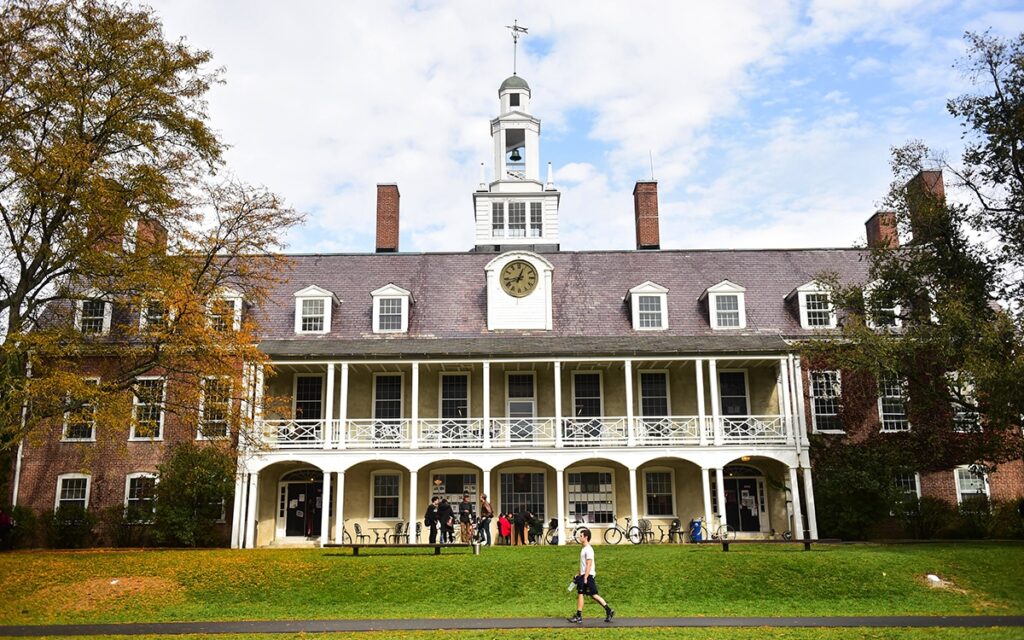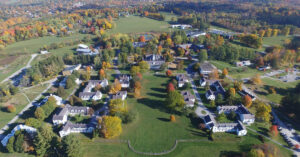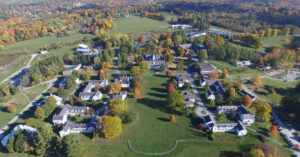
In the CAPA Symposium, most of a dozen students crowd around the center table. There’s a document up on the projector screen, and paragraph after paragraph scrolls past. Samuel De Sousa, a junior, stands in front of the screen, explaining what each section entails. There’s quiet discussions between members of the group; voices are lowered as concerns are raised.
This is the latest of only a few of the new Student Council’s meetings. There are mid-meeting discussions about how the meeting itself ought to be run; there’s uncertainty about decorum, procedure, and process. Some members hesitate before raising a motion, or calling for a vote on separating into break-out groups. As this is Student Council’s first term in action, it will still be a while before all of the kinks have been ironed out.
This is to be expected, most of the members agree. Muhammad Ammar, a junior who was closely involved in the council’s creation, says this aspect of confusion and education is accounted for in the council’s founding document. Ammar was involved in a tutorial in the spring semester of 2022 concerned with creating a charter for a new student government.
“We were able to draft a charter, and it was still a working draft by the time we completed it, but that was intentional,” Ammar said. “The zero clause, in fact, of the charter of the student government states that everything in this charter is subject to modification.”
The idea being, Ammar explained, the College needs a government which is able to respond to student’s needs in an efficient, pragmatic way. This focus on pragmatism was an essential component of the council’s creation, as much of the desire to create a student government came from widespread dissatisfaction with the previous institution.
Prior to this new Student Council, the Bennington College student body was ostensibly represented by the Student Union, a student club designed to address issues of concern in a democratic forum. The union’s performance, however, was less than completely satisfactory. Samuel De Sousa described their first interaction with the Student Union.
“The first question I asked to them was, what have you achieved in the past year? They didn’t say anything,” De Sousa recalls. “It was not pragmatic at all. It was very ideologically defined. I didn’t think it felt welcoming.”
Ammar seconded that description.
“What I realized right from the get go was that it didn’t enjoy any legitimacy with the student body because its membership was 0 to 20 students,” he said. “It was more of a student club than it was actually a consolidation of student interests.”
That being said, for a while the Student Union was the only form of student representation available to Bennington students. The previous student government, the Community Council, was dismantled as part of the restructuring conducted during the presidency of Elizabeth Coleman during the 1990s. Host to a rich history of strong student government, the Community Council, existed from as early as the 1940s until around 1994. Ammar described the strength of that institution.
“In the forties and fifties, the student government was able to issue driver’s licenses,” Ammar said. “Because the college had a post office, we had the legal jurisdiction to be giving out licenses. It was a big deal.”
(Records of the Community Council’s minutes are still available in the College’s archives.)
With the student government dismantled, for several years the Student Union was the only body making an effort to interface with the administration – an effort that was, by most accounts, largely more symbolic than successful.
“They did accomplish some meaningful stuff, eventually when it came to staff-workers rights and labor rights in the staff department, especially when dealing with buildings and grounds and dining employees. I think their efforts were commendable in that regard,” Ammar said. “But I think when it came to student interests it kind of fell off. And when that leadership graduated, the organization kind of fell flat.”
With the Student Union faltering, Ammar – and several other students – quickly recognized the need for a new institution. One that, they hoped, would possess the legitimacy and practicality which the Union lacked.
For Ammar, interest in a new student government began with a course offered by professor Eileen Scully, called “Governing America.” The course introduced Ammar to Bennington’s history of student governance, and prompted him to explore what the College had in the present day.
“I was like, I wonder what [student government] is like right now, and I learned that there is no body,” he said. “I was like, that seems alarming.”
He wasn’t the only one. A community town hall was hosted on the subject, and many students voiced their concerns. Before long, the biggest push for student government would come – but not from the students.
“So then in the spring, it so happened that the college realizes that there’s an accreditation called the NECHE,” Ammar explained. The NECHE is the New England Commission for Higher Education, an organization offering accreditation to post-secondary institutions if they comply with certain guidelines. “They conducted a report on Bennington to see what its accreditation status would be, and among the few things they highlighted for Bennington as challenges was student, faculty, and staff governance.”
This instigated what Ammar described as a “top-down” effort to create a student government. Beginning with the Board of Trustees, the administration undertook an effort to create a shared system governance for the College. To that end, a consultant named David Maxwell was hired. For more on that process, the Bennington Lens published this article on his hiring.
Following the formation of the Shared Governance Task Force in March, 2021, the College offered a tutorial on student government. Also sponsored by Dr. Scully, “Reimagining 21st Century Campus Governance” was, according to Ammar, mostly led by senior Sam Henriquez.
“If I’m being honest, the tutorial was really Sam’s brain child,” Ammar said. “He was the one who led all the bureaucracy for it, he was the one who would design the course plans.”
The outcome of this process was the Student Council’s charter, a document which laid out the rules and organization of the yet-unformed council. Even now, only a few weeks after the elections, the format of the council has already shifted. Originally, there were seats on the council for representatives from existing student organizations.
“The first step of the process was supposed to be getting nominated representatives from existing student bodies, so instead of forcing a new structure onto students we’re kind of phasing it in. Consolidating student interests, as well as student organizations,” Ammar said. “So we asked SEPC, house chairs, PAC and Budget and Events for representatives.”
It was not long before PAC and Budget and Events – two committees that were already being phased out – yielded their seats on the council and were replaced with two more elected representatives. Other than that, the biggest roadblock came with the SEPC representatives.
“What ended up happening was that SEPC raised concerns that all the other organizations had students working for them and being paid, and yet SEPC was involved in a conflict with the administration about not being paid,” Ammar explained. “So SEPC was like, we cannot give our go-ahead, we cannot elect a representative for student government without this inequity being addressed by the administration.”
The resolution came to the satisfaction of both parties; the administration agreed to pay SEPC representatives a $200 stipend in spring 2022, and the SEPC representative took their position on the Student Council in the fall of 2022.
Today, the council has reached a position where it can begin discussing policy proposals, which is currently the main form of power which the council exercises. The function of the council at present is to identify issues which the student body has with the college, identify solutions, and propose policy changes to the president.
The first proposal processed so far was written by Samuel De Sousa, which proposed an increase in the Field Work Term stipend offered to FLoW students from $500 to $1,000. The document, which includes statistics and testimonials gathered from students, also includes numerous other strategies intended to alleviate the financial hardships experienced by FLoW students during FWT.
While the proposal submitted was created by a representative, others are optimistic for a wider involvement in creating these proposals. Though each representative seems to have a short list of proposals they mean to sponsor, one representative during the meeting suggested the creation of a public form for students to fill out as suggestions for policy proposals.
As the meetings and discussions continue – and as the Student Council awaits an official response from the administration – there is one major struggle left for them to confront. In order for the Student Council to really start on its way to becoming a real successor to the Community Council, it needs one thing: legitimacy.
Off the bat, the Student Council had an important advantage over the Student Union. Due to the administration’s involvement in creating the organization, the Council has direct access to the administration, as well as explicit powers, a budget, and once proposals are submitted, a maximum period of ten business days for the administration to respond.
Although having its origins within the administration, the Student Council seeks to clarify the conception that the Student Council is in some way subservient to the administration; most representatives view it as being quite different.
“The fact that the student council is recognized by the administration does not mean that it’s a part of the administration,” De Sousa said. “I would say it’s in opposition to the administration. Our priorities are different in the sense that the administration has to think about the budget and financial sustainability, while we think mainly about our immediate needs, our wellbeing, and our education.”
Umang Malik, a sophomore representative, made it clear the administration’s positions and reservations are not really the Student Council’s concern.
“This is a body that exists to reflect the will of the students. It’s on the administration, what to do with that,” Malik said. “If we’re both representing one legitimate side of a fight, then hopefully through an honest, authentic conflict, there can be some actually acceptable compromise.”
Ultimately, the administration can never provide the recognition the Council is really seeking: that must come from the student body itself. Every representative spoken to agreed that the Student Council’s number one priority is becoming seen as a legitimate representative for the student body. Paige Colby, a sophomore representative, was one to voice this concern.
“We are focusing most on how we gain legitimacy. We have it on paper, it’s been set up,” Colby said. “But we are focusing now on how we make sure we are representing the student body, making sure the student body feels like we’re getting things done. I don’t want the student council to turn into the Student Union. I want it to go back to giving out driver’s licenses.”
A forthcoming second part of this story will discuss the first policy proposal in more detail. For more information, students are encouraged to follow the Student Council’s Instagram at @btonstudentgov, or to email btonstudentgov@bennington.edu.





Be First to Comment